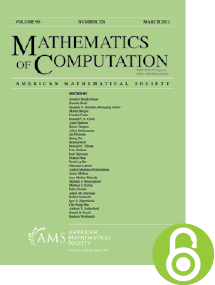Some properties of rank-$2$ lattice rules
HTML articles powered by AMS MathViewer
- by J. N. Lyness and I. H. Sloan PDF
- Math. Comp. 53 (1989), 627-637 Request permission
Abstract:
A rank-2 lattice rule is a quadrature rule for the (unit) s-dimensional hypercube, of the form \[ Qf = (1/{n_1}{n_2})\sum \limits _{{j_1} = 1}^{{n_1}} {\sum \limits _{{j_2} = 1}^{{n_2}} {\bar f({j_1}{{\mathbf {z}}_1}/{n_1} + {j_2}{{\mathbf {z}}_2}/{n_2}),} } \] which cannot be re-expressed in an analogous form with a single sum. Here $\bar f$ is a periodic extension of f, and ${{\mathbf {z}}_1}$, ${{\mathbf {z}}_2}$ are integer vectors. In this paper we discuss these rules in detail; in particular, we categorize a special subclass, whose leading one- and two-dimensional projections contain the maximum feasible number of abscissas. We show that rules of this subclass can be expressed uniquely in a simple tricycle form.References
-
H. Conroy, "Molecular Schrödinger equation, VIII: A new method for the evaluation of multidimensional integrals," J. Chem. Phys., v. 47, 1967, pp. 5307-5318.
- Seymour Haber, Numerical evaluation of multiple integrals, SIAM Rev. 12 (1970), 481–526. MR 285119, DOI 10.1137/1012102
- Seymour Haber, Parameters for integrating periodic functions of several variables, Math. Comp. 41 (1983), no. 163, 115–129. MR 701628, DOI 10.1090/S0025-5718-1983-0701628-X
- Edmund Hlawka, Zur angenäherten Berechnung mehrfacher Integrale, Monatsh. Math. 66 (1962), 140–151 (German). MR 143329, DOI 10.1007/BF01387711
- Loo Keng Hua and Yuan Wang, Applications of number theory to numerical analysis, Springer-Verlag, Berlin-New York; Kexue Chubanshe (Science Press), Beijing, 1981. Translated from the Chinese. MR 617192
- P. Keast, Optimal parameters for multidimensional integration, SIAM J. Numer. Anal. 10 (1973), 831–838. MR 353636, DOI 10.1137/0710068
- N. M. Korobov, Properties and calculation of optimal coefficients, Soviet Math. Dokl. 1 (1960), 696–700. MR 0120768
- Dominique Maisonneuve, Recherche et utilisation des “bons treillis”. Programmation et résultats numériques, Applications of number theory to numerical analysis (Proc. Sympos., Univ. Montréal, Montreal, Que., 1971) Academic Press, New York, 1972, pp. 121–201 (French, with English summary). MR 0343529
- Harald Niederreiter, Quasi-Monte Carlo methods and pseudo-random numbers, Bull. Amer. Math. Soc. 84 (1978), no. 6, 957–1041. MR 508447, DOI 10.1090/S0002-9904-1978-14532-7
- Ian H. Sloan, Lattice methods for multiple integration, Proceedings of the international conference on computational and applied mathematics (Leuven, 1984), 1985, pp. 131–143. MR 793949, DOI 10.1016/0377-0427(85)90012-3
- Ian H. Sloan and Philip J. Kachoyan, Lattice methods for multiple integration: theory, error analysis and examples, SIAM J. Numer. Anal. 24 (1987), no. 1, 116–128. MR 874739, DOI 10.1137/0724010
- Ian H. Sloan and James N. Lyness, The representation of lattice quadrature rules as multiple sums, Math. Comp. 52 (1989), no. 185, 81–94. MR 947468, DOI 10.1090/S0025-5718-1989-0947468-3
- S. C. Zaremba, Good lattice points, discrepancy, and numerical integration, Ann. Mat. Pura Appl. (4) 73 (1966), 293–317. MR 218018, DOI 10.1007/BF02415091
- S. K. Zaremba, La méthode des “bons treillis” pour le calcul des intégrales multiples, Applications of number theory to numerical analysis (Proc. Sympos., Univ. Montréal, Montreal, Que., 1971) Academic Press, New York, 1972, pp. 39–119 (French, with English summary). MR 0343530
Additional Information
- © Copyright 1989 American Mathematical Society
- Journal: Math. Comp. 53 (1989), 627-637
- MSC: Primary 65D32
- DOI: https://doi.org/10.1090/S0025-5718-1989-0982369-6
- MathSciNet review: 982369


